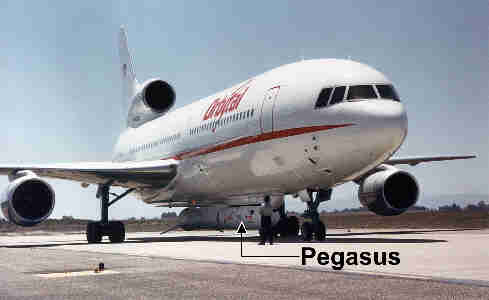By Dr. Tony Phillips
On April 28th a NASA spacecraft named GALEX left Earth. Its mission: to learn how galaxies are born, how they grow, and how they die.
"GALEX-short for Galaxy Evolution Explorer-is like a time machine," says Caltech astronomer Peter Friedman. It can see galaxies as far away as 10 billion light years, which is like looking 10 billion years into the past. The key to the mission is GALEX's ultraviolet (UV) telescope. UV rays are a telltale sign of hot young stars, newly formed, and also of galaxies crashing together. By studying the ultraviolet light emitted by galaxies, Friedman and colleagues hope to trace their evolution spanning billons of years.
This kind of work can't be done from the ground because Earth's atmosphere absorbs the most energetic UV rays. GALEX would have to go to space. To get it there, mission planners turned to Orbital Science Corporation's Pegasus rocket.
"Pegasus rockets are unusual because of the way they're launched-from the belly of an airplane," says GALEX Project Engineer Frank Surber of JPL.
It works like this: a modified L-1011 airliner nicknamed Stargazer carries the rocket to an altitude of 39,000 feet. The pilot pushes a button and the Pegasus drops free. For 5 seconds it plunges toward Earth, unpowered, which gives the Stargazer time to get away. Then the rocket ignites its engines and surges skyward. The travel time to space: only 11 minutes.
"The aircraft eliminates the need for a large first stage on the rocket," explains Surber. "Because Stargazer can be used for many missions, it becomes a re-useable first stage and makes the launch system cheaper in the long run." (To take advantage of this inexpensive launch system, GALEX designers had to make their spacecraft weigh less than 1000 lbs-the most a Pegasus can carry.)
A Pegasus has three stages--not counting the aircraft. "Its three solid rocket engines are similar to the black powder rockets used by amateurs. The main difference is that the fuel is cast into a solid chunk called a 'grain'-about the consistency of tire rubber. Like black powder rockets, once the grain is lit it burns to completion. There's no turning back."
In this case, turning back was not required. The rocket carried GALEX to Earth orbit and deployed the spacecraft flawlessly. On May 22nd, the UV telescope opened its cover and began observing galaxies-"first light" for GALEX and another success story for Pegasus.
For adults, find out more about the GALEX mission at http://www.galex.caltech.edu/ . Kids can read and see a video about Pegasus at http://spaceplace.nasa.gov/galex/pegasus.html.

L-1011 "Stargazer" takes off to carry Pegasus rocket on the first 39,000 feet of its climb to deliver a spacecraft to orbit.
This article was provided by the Jet Propulsion Laboratory, California Institute of Technology, under a contract with the National Aeronautics and Space Administration.

